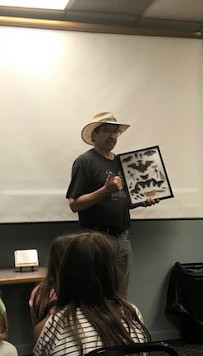SPOTSWOOD – An expert on bats recently discussed his knowledge of nature’s most famous – and only – flying mammal.
Jerry Schneider, an Ohio native who now lives in Vermont, visited the Spotswood Public Library on July 31.
When he was growing up, Schneider said, “We did not have many books in the library about bats or … we had scary stories like ‘Dracula.’ So most of my generation and my parents’ generation we were probably pretty afraid of bats. We didn’t care about bats, because we hardly saw them; they came out at night. We were day creatures, so if we saw a bat we would start freaking out.”
Schneider said recent generations have a different perspective on bats because there are more books on the subject, and more educational programs and television programs about bats.
“If you saw a bat lying around in your house, my mother wouldn’t ask, ‘Well, is that a big brown bat or a small brown bat?’ … she would get the broom and want to kill it, but some of the kids in this room probably would not do that,” Schneider said.
Bats are nature’s only flying mammal and there are more than 1,000 species in the world. Bats are nocturnal so they only come out at night to find food, and they mostly rest during the day, avoiding predators, according to Schneider.
A little brown bat can eat up to 1,000 mosquitoes per night and farmers like them because they eat beetles.
The most common bat in North America is the big brown bat, which has a wingspan of 10-14 inches and weighs 1 ounce, according to Schneider.
A little brown bat’s average lifespan is 35 years, but in general, bats can live up to 25 years. Baby bats are called pups and a female bat has an average of one bat per year, according to Schneider.
Bats use echolocation, which helps them navigate when they fly at night; however, humans cannot hear the sound because the bats’ frequency pitch is too high, he said.
Schneider said a bat’s wings are like human hands where their bones are stretched out to form their wings.
“Another important thing bats do is disperse seeds, so our rainforest would not be what it is without bats,” Schneider said.
As part of their evolution, bats hang upside down so they can escape a lot faster and fly away from predators, according to Schneider.
Bats go into hibernation because in the winter the insect population, which is their main food source, disappears.
“White-nose syndrome” has affected bats, especially when they are hibernating, according to Schneider.
“If [a bat] has white-nose syndrome’ it wakes them up and when they wake up guess what happens? Their body’s metabolism starts getting more and more energized and they use more energy,” Schneider said. “Then they get hungry and they fly out into (the cold weather) and there is no food. So that is what has killed off about 2 million little brown bats over the last 10 years.”
Schneider said ongoing development also takes away bats’ habitats.
During his presentation, Schneider showed photos of different bats that were taken by photographer and educator Merlin Tuttle, some of which included the Mexican long tongue, leaf-nose, southern blossom, bumblebee, flying fox, Mexican free-tailed, northern long-eared and vampire.
The vampire bat can be found in Mexico, but it does not suck blood with its fangs, Schneider said.
“They use their sharp teeth to scrape the skin of cows, pigs, horses or chickens. They have something in their saliva that numbs the skin so the animal they are biting does not feel it,” he said.
With their legs being more developed than other bats, Schneider said vampire bats can run fast.
All bats carry rabies, but they will only bite if they feel threatened, according to Schneider.
Schneider also played bat calls that were recorded by Tuttle.
Following his presentation, Schneider helped the children in attendance make their own bat T-shits by using stencils and blue and red fabric dye.
Contact Vashti Harris at [email protected].

